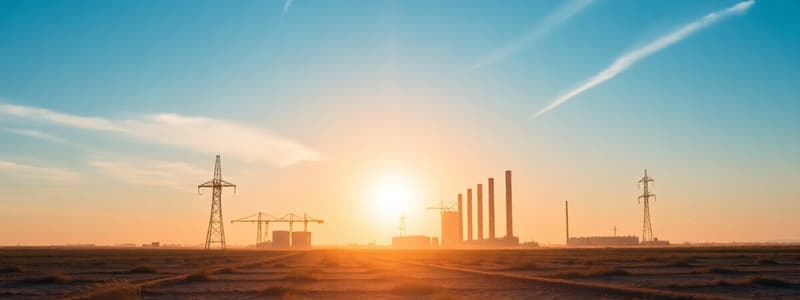Podcast
Questions and Answers
What is the primary cause of the increase in global temperatures?
What is the primary cause of the increase in global temperatures?
- Solar activity
- Greenhouse gas emissions from human activity (correct)
- Natural fluctuations
- Volcanic eruptions
The majority of scientists support the idea that global warming is caused solely by natural fluctuations.
The majority of scientists support the idea that global warming is caused solely by natural fluctuations.
False (B)
What is the greenhouse effect?
What is the greenhouse effect?
The bouncing of Earth's heat energy off greenhouse gases back towards the Earth's surface.
The greenhouse gases include carbon dioxide (CO2), methane (CH4), and _______.
The greenhouse gases include carbon dioxide (CO2), methane (CH4), and _______.
Which of the following activities is NOT a human activity that contributes to rapid climate change?
Which of the following activities is NOT a human activity that contributes to rapid climate change?
Match the measurement method with its description:
Match the measurement method with its description:
The rise in ocean water levels is caused by the increase in _______.
The rise in ocean water levels is caused by the increase in _______.
The countries that have contributed the least to climate change are the ones suffering the most from its effects.
The countries that have contributed the least to climate change are the ones suffering the most from its effects.
What percentage of the atmosphere is comprised of Nitrogen (N2)?
What percentage of the atmosphere is comprised of Nitrogen (N2)?
The climate of a place is determined by short-term atmospheric conditions.
The climate of a place is determined by short-term atmospheric conditions.
What are the four interrelated physical systems of the Earth?
What are the four interrelated physical systems of the Earth?
The __________ decreases as altitude increases in the troposphere.
The __________ decreases as altitude increases in the troposphere.
Match the layers of the atmosphere with their temperature trends:
Match the layers of the atmosphere with their temperature trends:
Flashcards
Climate Change
Climate Change
A long-term shift in average temperatures and weather patterns.
Greenhouse Effect
Greenhouse Effect
The process where gases in the atmosphere trap heat and warm the Earth.
Greenhouse Gases
Greenhouse Gases
Gases like CO2, methane, and water vapor that trap heat in the atmosphere.
Global Warming
Global Warming
Signup and view all the flashcards
Sea Level Rise
Sea Level Rise
Signup and view all the flashcards
Human Activities (Climate Change)
Human Activities (Climate Change)
Signup and view all the flashcards
Ice Core Measurements
Ice Core Measurements
Signup and view all the flashcards
Measuring Long-Term Temperature Changes
Measuring Long-Term Temperature Changes
Signup and view all the flashcards
What happens with a 1°C global temperature increase?
What happens with a 1°C global temperature increase?
Signup and view all the flashcards
Renewable Energy Sources
Renewable Energy Sources
Signup and view all the flashcards
Earth's Physical Systems
Earth's Physical Systems
Signup and view all the flashcards
Atmosphere's Role in Temperature
Atmosphere's Role in Temperature
Signup and view all the flashcards
What is the Troposphere?
What is the Troposphere?
Signup and view all the flashcards
Study Notes
Climate Change (Lecture 4)
- Climate change is a shift in average temperatures and weather patterns over a long time period.
- The planet is warming due to climate change.
- Rising temperatures cause sea levels to rise.
- Rising sea levels flood coastal areas, destroying habitats and displacing people.
- Warming temperatures reduce sea ice.
- Sea ice reflects 80% of sunlight back into space.
- Global temperatures are rising due to existing greenhouse gases in the atmosphere.
- Greenhouse gases include carbon dioxide (CO2), methane (CH4), and water vapor (H2O).
- Greenhouse gases trap heat in the atmosphere.
- Main human activities contributing to climate change are burning fossil fuels, deforestation, and reducing biodiversity.
- The USA, EU, and China are responsible for approximately 60% of climate change.
- Countries least responsible for climate change are often most affected.
- The greenhouse effect is the trapping of heat energy by greenhouse gases.
- Measuring recent temperature changes is done directly with thermometers.
- Measuring long-term changes is done indirectly using ice cores, coral remains, tree rings, and historical records.
- Effects of warmer temperatures include melting glaciers, rising sea levels, and increased ocean water levels.
- The majority of scientists believe global warming is due to human activity, specifically greenhouse gas emissions.
- A minority of scientists believe global warming is due to natural fluctuations.
- A 1°C increase in global temperature will lead to melting glaciers, island flooding, coastal flooding, changes in weather patterns, difficulty in growing food, floods/droughts, salt water contaminating fresh water supplies, and increased mortality related to weather.
- Renewable energy sources are an alternative to burning fossil fuels.
- Earth's four interconnected systems are the lithosphere, biosphere, hydrosphere, and atmosphere.
- The atmosphere traps solar energy, keeping Earth's surface warm enough for liquid water to exist.
- The atmosphere is a mix of permanent and variable gases, along with suspended microscopic particles.
- Nitrogen (N2) comprises 78% of the atmosphere.
- Weather is the day-to-day or short-term atmospheric conditions.
- Climate is the average weather condition over several decades.
- Troposphere temperature decreases with altitude.
- Stratosphere temperature increases with altitude.
- Mesosphere temperature decreases with altitude.
- Estimated average temperature without greenhouse gases is -5°C.
- Actual Average Temperature is 15°C.
Studying That Suits You
Use AI to generate personalized quizzes and flashcards to suit your learning preferences.



